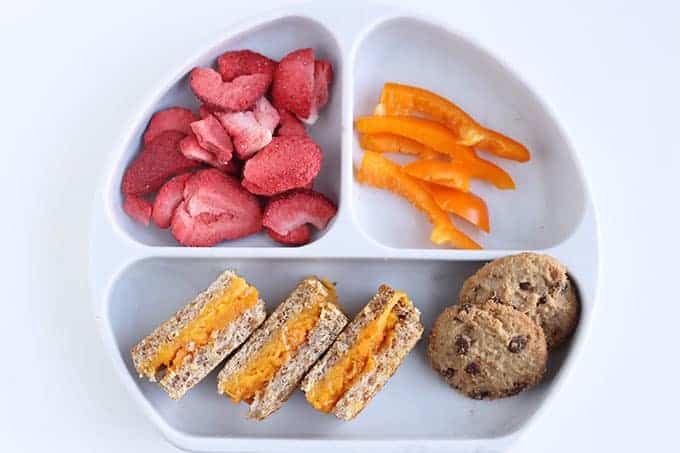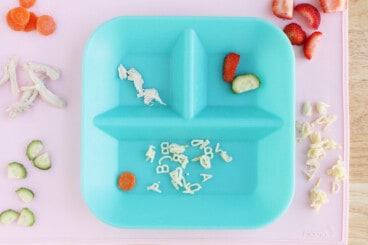You may have seen recommendations on serving dessert or treat foods right along with a meal and how it can be a helpful strategy when feeding kids. It seems counterintuitive, but it’s a great way to minimize how much kids fixate on desserts. Here’s why.

Dessert for Kids
I know firsthand that it often seems like the kids are getting so many treats, and that they’re eating more treats than regular food. Plus, there’s the fact that desserts just taste good, so kids tend to prefer eating them to more regular foods. It makes sense, but of course it’s not very helpful when it comes time for dinner.
But it can actually help to reduce the amount of time you spend negotiating and listening to fussing and obsessing if you regularly serve dessert right along with dinner.
Why Serving Dessert with Dinner Helps
“Offering dessert as part of the meal or with snacks can take some of the novelty away,” says Elizabeth Davenport, a registered dietician who works with families in her North Carolina practice. “It also allows children to tune into their cues and eat what they’re truly hungry for.”
“A child who isn’t offered dessert regularly or is in a home where dessert is built up to be a ‘big treat’ may initially eat the dessert first (and sometimes in a hurry) when it’s offered at a meal or snack,” she explains. “A child who is offered it regularly might eat the cookie or mini cupcake first or they might take a few bites of the cookie, put it down, and take a few bites of another part of their dinner.”
Think about what you want your family’s relationship with dessert to look like, and then come up with a loose structure that will foster that. Feeding therapist Ellyn Satter (who’s behind the Division of Responsibility) recommends offering one child-size serving of dessert with other foods so all foods are on the plate at the same time and are treated the same way. If you serve dessert this way every night, it may make sense to limit kids to that one serving, so the dessert food doesn’t steal too much focus from the rest of the meal.
(Note that “child-size” may mean different things to different people so it’s important to not aim to be overly restrictive with the portion since the kids may realize that the amount is very small if it’s less than they’d usually see.)
“If a child says they’re still hungry, you can ask them if they’d like more of dinner,” Elizabeth says. “Or if you serve the dessert after dinner has been put away, offer something else like yogurt and fruit or a bowl of cereal to round things out.”
This Isn’t About Getting Kids to Eat Less
But this isn’t about limiting kids’ treats; it’s because dessert foods tend to be easier to learn to like than other foods, and we want to make sure they’re getting plenty of learning opportunities across the board.
The key is to serve the dessert right alongside the other foods so it’s an equal part of the meal. It may seem strange to put a cookie next to the Brussels sprouts, but when you do this, you’re telling your child that these foods are morally equivalent—and that she’s not good or bad for liking one over the other. That frees her up to explore them on her own terms, without worrying about pleasing you or earning credit. (This also works at snack time, when you could pair M&Ms with milk and fruit or chips with hummus and cucumbers.)
But remember: On any given day, your kids may not eat equal amounts of each food and that is OK.
Why Dessert Shouldn’t Be Used as a Reward
From everything I know, it’s not very helpful to use dessert as a reward for eating dinner because nobody needs to “earn” the right to eat a food they love. Plus, a famous study by nutrition researcher Leann Birch showed that when children were pressured to finish their soup in order to get dessert, they eat less soup overall and liked it less than the kids who were allowed to eat dessert regardless of whether they finished the main meal.
And when we pressure kids to eat certain foods for any reason, they are less likely to eat those foods on their own later on.
So, let food be food and remember that you still get to decide which foods to serve when, but your kids will decide how much they eat of both dinner and dessert.
TIP: Find a list of fun rewards for kids here.
What counts as dessert?
I’ve often been asked what a parent should do when a child loves fruit, or how to handle it when a child treats fruit like dessert. It’s so easy to start to classify foods that our kids love that sometimes get a bad rap—including fruit because it contains sugar, “processed foods” like snack bars and crackers, and straight-up desserts like ice cream and cookies—as foods that should be limited.
And while it’s important to me that I provide my kids with a range of food options each week to help them eat a variety of foods, it’s also important that I don’t restrict too many foods out of fear that they’ll like them and want to eat them.
I’ve always found that the more I try to prevent my kids from eating certain foods, the more they want those foods. And that is the exact opposite of what I’m hoping to do with my goal of raising kids who feel safe and happy and confident around all sorts of foods and eating experiences.
You could make a short list of what’s going to constitute dessert—maybe it’s cookies, brownies, and ice cream—and leave your kids in charge of “how much” on everything else. (Review how this works in the Division of Responsibility.)
You’ll still want to provide some regular occasions when the kids get to have their fill of dessert without you limiting it to one serving. This might look like baking cookies together on a weekend afternoon, and then enjoying as many as you want while they are warm from the oven. Or letting them make their own sundaes with all the crazy toppings they can imagine. This is important because it lets them practice self-regulation around these foods and reduces food fixations—and getting to eat your fill of delicious brownies or ice cream is also just one of the best parts of being human!
PS: I tend to ignore treats for toddlers under 2 or until they start to be aware that these foods exist. The time will naturally come and until then, there’s no real need to force or offer sweets unless you want to.
Related Posts
I’d love to hear your thoughts on this, so please comment below to ask questions or to share your thoughts!























Something that’s worked for me is offering a token amount of the post-dinner treat as an “entree” of sorts. She’s then happy to move onto her main meal. Holding it hostage until post dinner led to a meltdown and refusal to eat the rest of her food. It’s been a game changer! I guess this works because her post dinner treat is normally frozen mango, so her entree is 2-3 small pieces, which doesn’t spoil her appetite.
I do this pretty much consistently but he only eats the fruit or “sweet” and leaves the pasta, homemade food
What happens if my child continually only eats the dessert on her plate?
Generally speaking, you could look at if she’s feeling restricted with those foods and also if there are other foods in the meal that she usually likes to ensure she has other options to choose from. (You also don’t have to do this method if it’s not working for your family.)
Hi Amy, what can you say to a 2 year old when you want to limit the dessert to 1 serving? Thank you!
I usually say “This is what we’re having right now. We have other foods on the table if you’re still hungry and we can have more tomorrow!” Then I change the subject to something they love to talk/hear about.
I don’t really understand limiting dessert some of the time? Seems like the child would still pick up on it being restricted and would be confused why sometimes they can have as much as they want but sometimes not.
Simply because we eat more of some foods and less of others and you don’t always literally have unlimited amounts of dessert (or any other food). You can adjust this concept to work for you too if that doesn’t sit right.
can you point me to any evidence based research to support this for my child’s nursery please.
This is the study I link to in the post: https://www.ncbi.nlm.nih.gov/pmc/articles/PMC2604806/
This study offers evidence that pressuring kids to eat something may make then consume less of it. That’s fair and it makes sense.
However, it’s an entirely different thing to offer dessert with dinner. Sure, you may elevate their perception of brussel sprouts relative to cookies, but in my experience, there’s not a single time where they don’t finish their cookie first, leaving less room for dinner.
I’d love to hear from anyone with success with this tactic.
I’ve seen this advice in a few different places, and it really makes sense to me. My husband and I would prefer to wait a bit after dinner and then have dessert, but that would mean dessert is always after bedtime for the toddler. Getting out the dessert at the end of mealtime seems like it could mess with the hunger/fullness cues we’re wanting him to learn (and should pay better attention to ourselves). So the dessert with the meal approach sounds promising to me. However, we have a challenge with implementing it.
My son is 23 months old and likes most all foods. If there’s something he particularly likes, he usually eats it first, and then will often ask for more of that before starting on his other food. We typically portion out our food onto our plates before bringing them to the table, so there’s not a serving dish from which to obtain “more” of anything, so we will often give him a little bit more from our plates. Last night, we tried putting our cookies on our plates with dinner. Of course, my son ate his cookie first, and wanted “more” of ours. My husband and I aren’t keen on eating our cookies first, but that’s hard to explain to a toddler. Having cookies on our plate that we aren’t sharing is too much temptation for the little guy to handle, resulting in a complete meltdown and unpleasant family dinner. We want to model a healthy relationship with all foods, but cookies on the dinner plate isn’t working in our house right now. Any tips for doing this better?
I understand that putting this into practice can be hard! Do you think it would help if you and your husband waited to have yours until he went to bed? If you don’t actually want to eat yours with your dinner, you don’t have to. (And I don’t know that there’s really any “doing this better” here, it’s all trial and error to figure out how to make these things work.) With any of this, you’ll have to do it regularly for the child to understand what the routine of it is, so it may take a few unpleasant times for him to understand that there’s not more…of course, if this is too stressful, you can simply wait until he’s older and let dessert happen as it naturally does on the weekend, at parties, or holidays. You don’t need to necessarily make it happen regularly if he’s not quite able to understand the system. You could still offer times on the weekends for him to enjoy cookies with a plate to share on the table, say at snack time or if you bake them together, so he can have the experience of eating his fill and experience not being restricted around a food he loves.